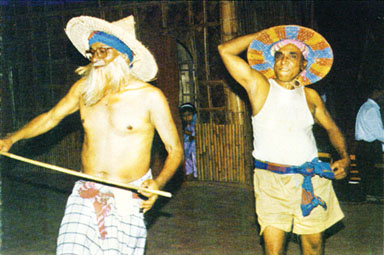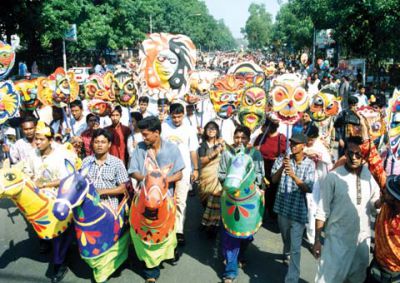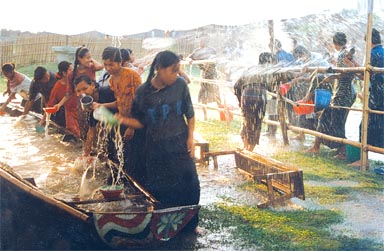Folk Festivals
Folk Festivals originate from religious rites to appease gods and other unseen powers. In agricultural Bangladesh, as in other agricultural communities, such festivities are closely related to farming and cattle-raising, to human and crop fertility.
The prehistoric cult of sacrificing maidens and other humans at festivals to appease nature and the sun god have long disappeared. The traditions of other festivals are still alive but have undergone considerable changes.

Being predominantly an agricultural land, Bangladesh has several festivals related to farming. A number of these festivals call upon the sun god or the rain god to give rain. Among these festivals are byanbiye, badnabiye, megharani and hudmadeo rites and punyipukur brata and basudhara brata. In Huduma Deo rites groups of aboriginal women go into the fields at night, undress, and sing in chorus imploring the rain god, Huduma, to bestow rain. A mud festival is also held to invite rain
In this festival, women, carrying water pitchers, go around houses smearing mud on each other. Kulanamano is another rain- inducing ritual in which women carrying decorated kula or winnowing fans go round houses singing songs inviting rain.
Ambubachi a special folk festival of the Hindus. It is a three-day ritual observed by women beginning on the seventh day of Asadh. It is believed that during these three days there occurs a union of the sky and the earth and this drenches the earth to make it fit for farming. It is forbidden to dig or plow during this period. Hindu widows observe some restrictions during these days. Special foods and rice cakes are prepared during this festival.
Berabhasan or raft festival is celebrated wherever there are large waterbodies. It is held on the last Thursday of Bhadra in honour of khowaj-khizir (installed in place of the water god Varuna). It is arranged both on social or family initiatives or by the community of fakirs. During Mughal rule, it used to be observed with great pomp at Murshidabad, Rajmahal and dhaka at the initiative of nawabs or naib-e-nazims. In patronising it, Mukarram Khan, Nawab sirajuddaula and Mir Qasim played prominent roles. It was through their patronage that this folk festival developed into a national festival. In this festival a banana plant is felled at one blow and made into a raft. A variety of sweet offerings are placed on it and then, as people sing, it is pushed into the water to drift away. It is believed that this observance will provide protection against drowing.
Chadak Puja an important folk festival of the Hindus. It is held towards the end of Chaitra and the beginning of Baishakh. This is more common in the areas of faridpur and barisal, which were Hindu majority areas. Mela or fairs lasting for two or three days are held on this occasion.
Gasbi an autumn festival observed to ensure a better harvest. The observance starts on the last night of the month of Ashvin. The next morning, the first day of Kartik, a shundi (a sweet-smelling root) paste is made of green turmeric and mustard oil which is then dabbed on paddy plants in the hope of a better crop
In the past people would cook food on the last day of Axvin and eat it the next day. This custom was followed because of a folk saying that if one cooked food in Asvin and ate it in Kartik, his wishes would be fulfilled. This festival is no longer in vogue, due perhaps to climatic change.
Navanna a special folk festival. It used to be observed with a lot of fanfare after the new crop came home in the month of Agrahayan. Before sunrise on the day of the festival, children would recite rhymes inviting crows to their houses: 'Ko ko ko, today there is a new rice feast in our house/ come and eat food made of new rice/ crows get a kick/ ravens get bananas/ ko ko ko, our house has a new rice feast today'. On this day new rice is pounded in a dheki, or husking pedal. A hole is dug in the courtyard, into which a live kai fish is put with milk. A bamboo pole is fixed in the hole. Around the pole, called bir bansh, alpana is drawn with rice paste. At every joint of the bamboo a sheaf of new paddy is tied. Then some rice, a banana and a coconut sweet are offered to a crow. The flight of the crow is closely watched. It is believed that the fortunes of the year depend on the course of its flight. This ceremony is called kakbali. No one takes food before concluding this ceremony and offering puja and food made of new rice to Laksmi, the goddess of crops, and to the crow. On this day every family prepares delicious dishes. People may eat navanna in another house during the day but they must eat at home at night. Navanna is wound up the next day with basi navanna, which means eating the left-overs. Muslim families also celebrated navanna. They too used to make offerings in the name of Laksmi. They called it nayakhaoya or new food. Navanna continues to be celebrated all over Bangladesh today.
Pausparvan/posla a crop festival. In the evening boys would go around singing, Muslim boys singing songs of Manik Pir and Hindu boys reciting rhymes to Laksmi. They would visit different houses during Paus, collecting money for festivities. On the last day of the month, they used to cook food in a field or near a forest and, after offering cakes or sweets to the pir or the goddess, partake of the food themselves. This was also known as pithaparvan or cake festival. These days Pausparvan is celebrated more in the cities than in the villages.
tusu and bhadu festivals in West Bengal are also based on farming practices. Even today these are celebrated quite colourfully. Hindu women of Purulia district worship Bhadu during the month of Bhadra. An elderly woman throws flowers at the image of goddess Bhadu while others sing Bhadu songs. On the concluding day they watch with tearful eyes the immersion of the deity.
Karam festival of the oraon tribe is celebrated at the end of Bhadra. It is dedicated to the worship of the karam tree. In the north it is also called bhadaiparva, barsaparva etc.
This festival is an occasion for teenaged Oraon youths and maidens to dance, sing and drink. All these festivities are not merely to worship the karam tree but in fact to create an atmosphere for the young Oraon to exchange expressions of love. Preparations for the occasion are made during the previous night. The youths fast the whole of the next day. In the evening they gather round the karam tree. The women sing and both men and women dance.

Pahela Baishakh Bengali new year's day, is now celebrated at the national level. On the last day of Chaitra, the last month of the Bengali calendar, farmers' wives prepare amani by soaking green mango and rice in a large earthen vessel. A leafy mango twig is also placed in the vessel. At dawn everybody eats the soaked rice while the water in the vessel is sprinkled on their bodies with the help of the mango twig. They believe this keeps the body cool in the hot summer. Every family prepares special delicious dishes in the belief that a good meal at the start of the year will set the trend for the whole year. Fairs are held on the occasion in cities, towns and villages. Halkhata is also a new year festival. On this day traders close old accounts and open new ones. On the occasion they invite their clients and give them sweets. Their clients are supposed to clear all old debts. This is a practice common in both urban and rural areas.
Punyah used to be celebrated by zamindars and was connected with the collection of revenue. On the first day of the new year, the tenants paid taxes to the zamindars and in turn the zamindars paid their dues to the government. The tenants would go to the zamindars' kachharies wearing new dresses. Fairs, and music, dances and plays were part of the celebration.
Suryavrata a festival exclusively for Hindu maidens. It is also known as lalthakurer vrata, sindipuja etc. It was widely practised with girls observing it throughout the month of Magh. They started with an exercise of self-control on the last day of Paus. Early next day, the first day of Magh, all the girls would go to the waterfront and recite a hymn thrice before taking a dip in the water. At the end of their bath, they would hold water in their clasped palms and worship the sun while reciting hymns. Then they would walk back home to worship at the Tulsi pedestal. After the puja they would seek the sun god's blessings. This would go on for the whole month. Every Sunday the girls would eat only vegetarian dishes. They would prepare a banana raft and place unboiled rice, sugar, molasses candy, butter oil, honey, banana and an oil-lamp on it. Then they would carry it on their heads to the waterfront followed by a group of women singing. They would set the raft adrift, praying for good husbands, happy family life and financial solvency.

Sagrai a new year festival of the indigenous tribes. The tribes of the Chittagong Hill Tracts celebrate it with great pomp to bid farewell to the old year and greet the new year. It is a four-day festival covering three days of the outgoing year and one day of the incoming year.
On the first day, men and women of the marma tribe take the Buddha images in a procession to the riverfront to wash them on a banana raft with sandalwood and water or milk and water and reinstall them at the temple or at home. The last two days of the old year are days of great enjoyment. During this time they celebrate panikhela or playing with water.
They throw water on each other to wash away all the ills, miseries and sorrows of the passing year. Then they greet the first day of the new year with fun and frolic. On this day the
rakhainf play rabgpani, when they drench each other with coloured water. The chakmas celebrate bijhu festival with great fanfare during the last two days of the outgoing year and the first day of the new year. The first day is for phul bijhu, the second day for mul bijhu and the new year's day for gojyai pojya.
The Chakmas spend the first two days in merrymaking and abstain from work. Mul bijhu is their core festival. On this day they visit each other’s houses and feast. Young girls roam about wearing blue and red lungis woven on their handheld looms. In the afternoon they play games.
Every year on the first day of Kartik a festival is held at Cheuria in kushtia in memory of lalon shahFakirs or devotees of Lalon also join in. A fair is held on the occasion. The followers of Lalon and other folk singers present Lalon songs there.
Some folk sports, such as boat races and bullfighting, also assume the proportion of folk festivals. Boat races draw huge crowds of people as do wrestling matches such as Jabbar's bali khela in chittagong.
Though weddings are social events, the ceremonies and rituals associated with them are in the nature of folk festivals. Once a marriage is arranged, close relations start visiting the homes of both parties to attend a variety of rites. Such ceremonies as aiburobhat, gaye halud and adhibas heighten the joy of marriage. In the past a clash of lathiyals or skilled fighters with bamboo staffs was common in some places. The groom could enter the wedding arena only if his men won. At times quiz contests were part of the ceremonies. Even to this day the groom is held up at the gate by the youngsters of the bride's side until he parts with some prize money. Wedding songs, describing the rituals or making fun of the other side, add to the merriment. These days, Gaye halud or smearing of the bride and the groom with turmeric paste, is observed as an essential event. Many rituals are associated with fertility.
Ceremonies connected with aqiqah, annaprashana and khatna may not be as widespread as those of weddings but nevertheless are observed in some areas with a fair amount of pomp. In many parts of the country, as well as the older parts of Dhaka, a boy who is newly circumcised is given new clothes to wear after a bath and then taken round in a horse carriage. [Momen Chowdhury]
Bibliography Shila Basak, Banglar Brata Parvan, Calcutta, 1998; Ashutosh Bhattacharya, Banglar Loksruti, Calcutta, 1999; Momen Chowdhury, Loksanskar O Bibidha Prasanga, Bangla Academy, Dhaka, 1997; JA Hanafi, Upajatiya Nandan Sanskriti, Bangladesh Shilpakala Academy, Dhaka, 1993; MA Jalil, Lokasanskritir Nana Prasanga, Bangla Academy, Dhaka, 1995; Atwar Rahman, Utsav, Bangla Academy, Dhaka, 1986.
See also chaitra sangkranti mela; chadak puja; festivals.
